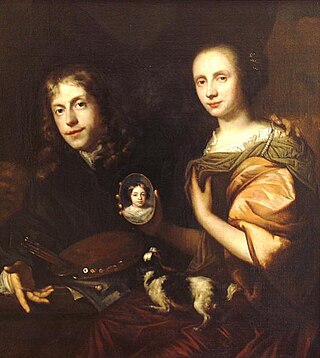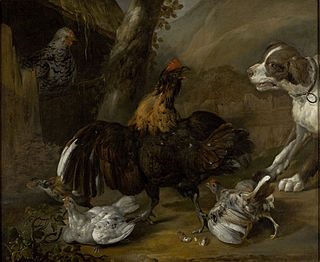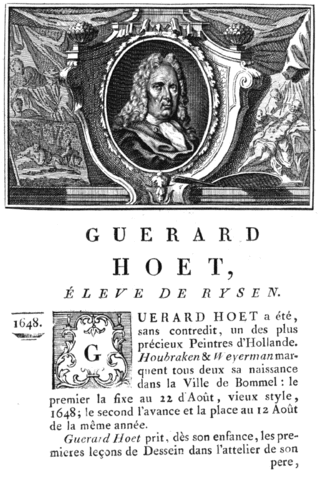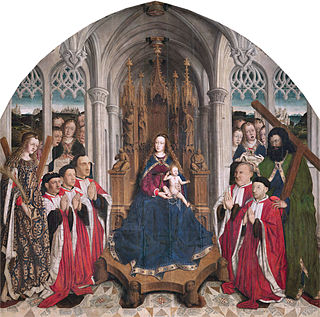
Michiel Janszoonvan Mierevelt was a Dutch painter and draftsman of the Dutch Golden Age.

Jan Anthonisz van Ravesteyn was a successful portrait painter to the Dutch court in The Hague.

Adriaen Hanneman was a Dutch Golden Age painter best known for his portraits of the exiled British royal court. His style was strongly influenced by his contemporary, Anthony van Dyck.

Jan de Baen was a Dutch portrait painter who lived during the Dutch Golden Age. He was a pupil of the painter Jacob Adriaensz Backer in Amsterdam from 1645 to 1648. He worked for Charles II of England in his Dutch exile, and from 1660 until his death he lived and worked in The Hague. His portraits were popular in his day, and he painted the most distinguished people of his time.

Adriaen, or Jan van Alen (1651–1698) was a Dutch painter from the Northern Netherlands. He was born as the son of the animal painter Jacob van Oolen in Amsterdam, with whom his works are sometimes confused. He became an imitator of Melchior Hondekoeter, and his pictures, like those of that master, represent fowls, landscapes, and still-life.

Willem Doudijns (1630–1697), was a Dutch Golden Age painter and engraver.

Petrus Johannes van Regemorter was a Flemish landscape and genre painter, born in Antwerp. He was a pupil of the Royal Academy of Fine Arts, but frequently studied pictures from private collections. He became a professor in the Academy, and Dean in the Painters' Guild in 1786. Many artists of note studied under him, and he had a large practice as a picture-restorer. In 1814 he was engaged in bringing back the pictures taken by the French to Paris. He died in 1830. In the Antwerp Museum is a Shepherd and Flock by him. He excelled in painting moonlights.

Arnold van Boonen was a Dutch portrait painter.

Gerard Hoet was a Dutch Golden Age painter and engraver.

Everard "Evert" Crynsz. van der Maes, was a Dutch Golden Age painter.

Lluís Dalmau was a Spanish-Valencian painter. He was active in Barcelona from 1428 to 1460 and served the king of Spain in an official capacity. In 1431, King Alfonso V sent him to Flanders to learn the language of realist painting. He made a copy of the Adoration of the Lamb by Hubert and Jan van Eyck; in 1432, this was placed in St Bavo's Cathedral, Ghent. The next year, he had returned to Barcelona. In 1443, Dalmau was commissioned to paint the Virgin of the Consellers altarpiece for the chapel of the City Hall, which he completed in 1445; this is perhaps the only known work of his to survive. In 1445, he also painted a Virgin and Child in the style of Jan van Eyck, which is in the church of San Miguel at Barcelona.

Frans Decker was an 18th-century painter from the Northern Netherlands.

Adriaan de Lelie was a Dutch painter.

Adriaen van Diest (1655–1704) was a Dutch painter, who worked in England.
Roeland van Eynden was a Dutch painter. He was born at Nymegen in 1747, and died at Dordrecht in 1819. Like his brother he devoted but a portion of his time to painting, and is principally known by his works on art and artists, of which the most important is the Geschiedenis der Vaderlandsche Schilderkunst, written in conjunction with Van der Willigen, and published in 1816–1842.

Arnold van Ravesteyn, was a Dutch Golden Age portrait painter.
Jan Baptist Francken was supposed to be a painter from the Francken family and/or the son of Sebastian Vrancx, but is now considered to have been an error and to have never existed. The confusion was created by the many painters named Francken, some poor attributions, and a portrait by Anthony van Dyck of a certain Johannes Baptist Franck, aged 32, of whom nothing more is known. He is sometimes said to be the same as Hans Francken, another obscure member of the same family.

Dirck de Quade van Ravesteyn, was a Dutch Golden Age painter active in the court of Rudolf II, Holy Roman Emperor.
















